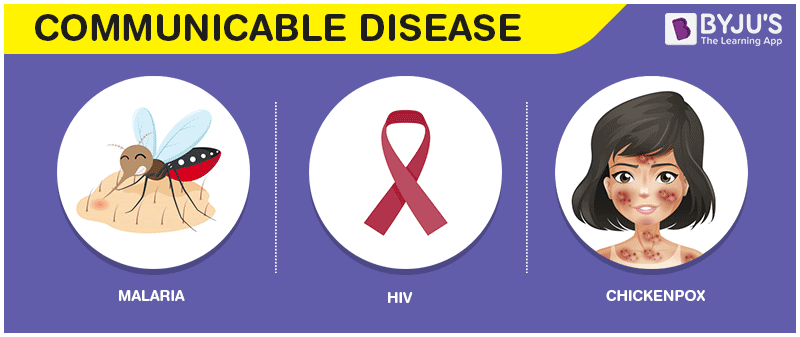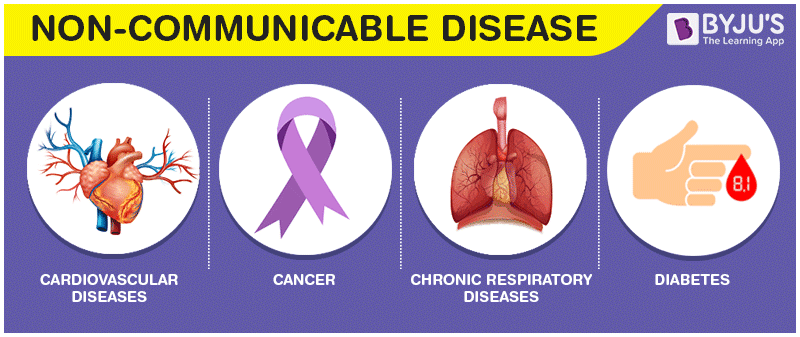Health is the state of physical, mental and social well-being. A disease is a factor which affects health. A disease can be defined as a condition or state of discomfort. It can be either due to structural disorder or functional abnormality in the body. Diseases can be classified based on certain criteria. Some of the criteria for classification are the duration of occurrence, communicability, type of causative agent and source of transmission. In this section, we will talk about communicable disease and the non-communicable disease.
Also Read: Difference between disinfection and sterilization
What is Disease?
Diseases are abnormalities in our body causing discomfort as a result of organs or organ systems being affected. Diagnosis of the disease is aided by signs which our body exhibits. These signs are called symptoms. Symptoms help in the accurate diagnosis of the disease under the careful supervision of an experienced physician.
Most of the diseases are contagious, they spread from one person to another through various modes such as air, water and contaminated food, or through vectors. Microbial agents move from an infected person to a non-infected person through different media. They are called communicable diseases since they are transmitted.
Microbes which can potentially cause a disease to spread through the air. This can be in the form of cough and sneezes from the mouth of an infected person in the form of tiny, almost invisible droplets. The ambient air is now infected, any person inhaling this air falls sick which harbours microbes with the capability to cause a new infection. Some common diseases that are spread through the air are – Pneumonia, Tuberculosis, Common cold. Airborne diseases are more likely to spread in a crowded ecosystem.
Also Refer: Health and Hygiene
Causes of Disease
Diseases can also spread through sexual contact with an infected person. Examples for sexually transmitted diseases are – AIDS, Syphilis, Gonorrhoea. These diseases are not spread through casual contact with an infected person such as hugs, handshakes, eating in their vicinity, playing sports or any other way in which we interact with them socially.
Viruses causing AIDS is the HIV which can spread through sexual contact or blood-to-blood contact from an infected person. It can also spread from an infected mother to her baby during her gestation period or breastfeeding.
Another mode by which diseases spread is water. This occurs when excreta of an infected person gets mixed with potable water in a community, for example, the excreta can be from a person diagnosed with cholera. Microbes are responsible for causing cholera to enter into the system of a non-infected person once the water is consumed causing cholera to spread. Proper treatment of drinking water can be helpful to keep a check on water-borne diseases.
Animals can act as hosts as they have the potential to carry pathogens and cause diseases to other animals and humans too, which usually occurs through direct contact. These animals are called vectors as they act as intermediaries carrying the infected agents. Mosquitoes are one of the most common vectors. Female mosquitoes require nutrition-rich food to produce mature eggs. They usually obtain required nutrition by feeding on human blood, hence transmitting diseases
Based on duration, diseases can be of two types:
- Acute disease
- Chronic disease.
An acute disease is such a type of disease which occurs for a short interval of time. An acute disease if not treated properly can eventually become a chronic disease.e.g. common cold, burn, etc.
Chronic disease is a disease which lasts for a long period of time e.g. Heart and kidney diseases.
On the basis of communicability, diseases are categorized into communicable or infectious disease and non-communicable or non-infectious disease.
Refer more: Causes Of Diseases
Let us learn more in detail about the types of disease
Communicable Disease

Infectious disease is caused by certain microorganisms called pathogens and leads to infections. These can be spread from one person to another hence are also called communicable disease. For example cholera, malaria, chickenpox.
Non-communicable Disease

Non-infectious are non-communicable diseases and caused by a variety of reasons. Some of the reasons for the non-infectious disease are genetics, nutritional deficiency, age and sex of the individual and so on. Examples include cancer, diabetes, and hypertension.
There are various disease-causing agents ranging from bacteria and viruses to protozoa and worms. These are collectively known as pathogens. These agents enter the body directly or through some vector/agents like mosquitoes. They cause infectious chronic disease. Then, there are prions, these are basically proteins that are folded the wrong way and tend to cause some very serious illness. These are not infectious in the usual way but can be spread by consumption of meat tainted by these proteins. Creutzfeldt-Jakob disease is such a disease caused by prions and is almost always fatal.
Some diseases are transmitted through some sources like contaminated food, water, and air. The chronic disease like AIDS is transmitted through blood transfusions, sexual intercourse, by sharing injection needles, even from mother to child by breastfeeding. Based on transmitting agents, a disease can either be airborne or water-borne or food-borne.
Whether the disease is acute or chronic, contagious or non-contagious, viral or bacterial in nature. They always induce an uncomfortable feeling in the body. And our daily routine gets disturbed as well. Hence, it is said that- “Prevention is better than cure”.
Also Refer: Human Diseases
To know more about the diseases, communicable and non-communicable diseases or any other related topics, visit us @ BYJU’S Biology.

What are communicable diseases? How do they spread?
Communicable diseases are those diseases, which can be transmitted from one person to another through various modes such as air, water, insects and other vectors, direct contact, etc. These are caused by infectious agents or pathogens such as virus, bacteria, protozoa, worms, etc.